The number of ATP certificates issued each year is something that helps us identify how many potential pilots are being qualified each year for service in airline operational environments. With active hiring over the past couple of years, the pressure to deliver ATP-certificated pilots has been strong.
Our industry has been delivering increasing numbers of ATP-certificated pilots over the past years, something that can be seen from the chart below.
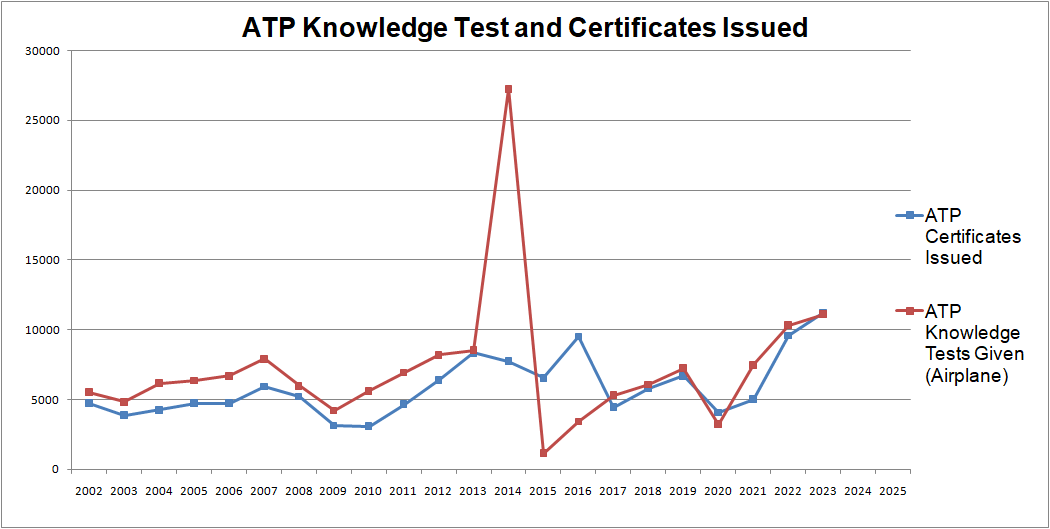
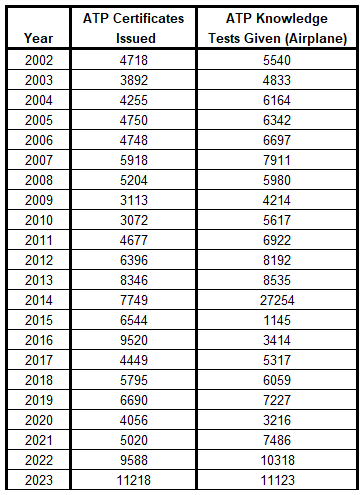 Increasing ATP Certification Trends
Increasing ATP Certification Trends
While there was a spike in 2014-2016 in ATP knowledge test and certificate issuance when regulations changed, the overall trend has been largely similar through the last decade or so.
Until 2021.
Since then, we have seen continued increases in ATP knowledge test completion and certification. Much of this is completed through the process of airline hiring and onboarding, beginning with completion of the ATP CTP course and finally with their ATP certification that coincides with a type rating for an aircraft they will be operating.
As many have indicated that there is a pilot shortage, this trend of increased certification would seem to indicate an increased ability to serve demand, decreasing the pressure of a pilot shortage. The longer this trend continues, the more our industry should be able to meet all hiring needs, and potentially even be more selective in hiring in terms of quality versus just quantity of hiring.
Through 2023 we saw a trend of certification that was outpacing all recent years on a month-by-month basis
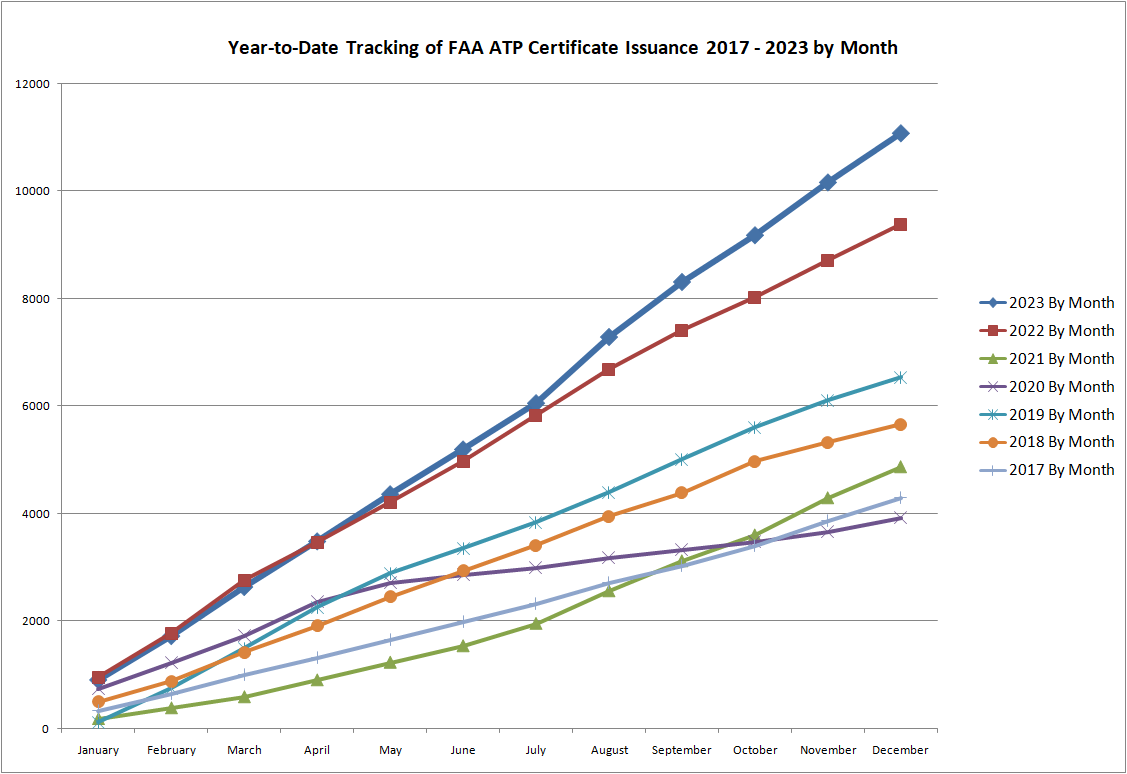
Will the trend continue?
This is a valid question as we enter the third month of 2024. Numerous airlines have reported slowing or even pausing of hiring at this time. It very much appears some fleet restructuring is happening that may change the mix of how many pilots are needed compared with passengers flown. Larger aircraft will take more passengers for fewer flights.
Secondarily, as airlines right-size their hiring, and cut back class sizes, this means we may see some dropoff in the flow of ATP certification. If the airlines slow hiring, especially those that are regional airlines that conduct much of the training and certification for initial ATP pilot certification, we may see the month-to-month trend begin to not pace as high as it has over the past two years. This is a trend that I will monitor in the upcoming months and share if I see any data of interest.
Aging ATP Pilot Population
Another interesting point that I think is worth looking at when it comes to our ATP pilot population is that it is aging.
Well, kind of.
From the chart below, we can see that from 2001 through 2021, the average age of an ATP certificate holder rose from just over 46 to a peak of over 51. In 2022, that average began to drop, and it did it again in 2023.
This is the average age of ALL pilot certificate holders who have an ATP certificate.
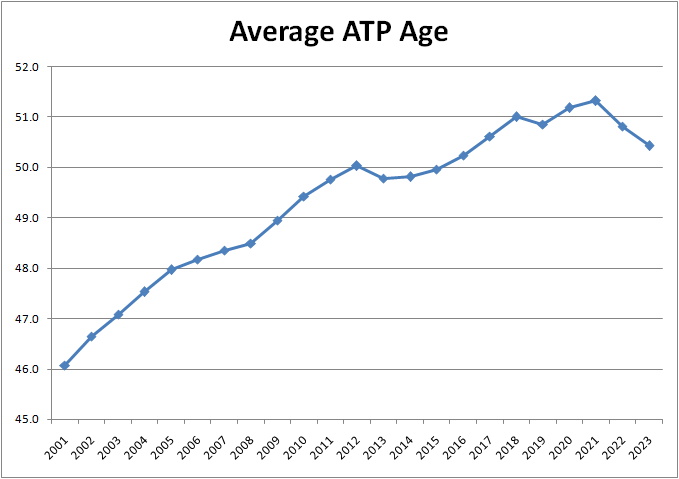
As we certificate more per year, those begin to weight our average downward with younger pilots. But it also seems to be an indication that our ATP pilot population may be dying off also. This may sound a little crass, but its actually pretty simple demographics. Our baby boomer generation of pilots is aging out and dying off. With that, we will eventually reduce the number of ATP pilot certificate holder numbers due simply to age.
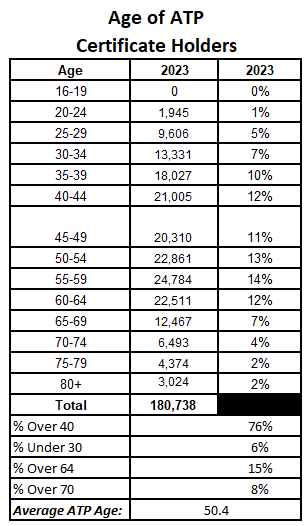
This is where some discussion also takes place in our industry about the age of ATP pilots and who may be allowed to fly in the airline operational environment.
The chart to the right here shows a snapshot of some of the demographics regarding the age of ATP pilot certificate holders at the end of 2023.
Fully 15% of those pilots are over the age of 64, which means they are subject to the mandatory retirement age of 65 for airline operations. While some discussion is taking place at the national level regarding proposals to extend the mandatory retirement age to 67, until such a time as that were to be made reality, we have at least 15% of our ATPs who are ineligible to provide service in airline operations.
Some will argue that those pilots may then move over to private or charter operational activities, but our industry has seen significant movement in those markets to limit pilots of more senior ages from service. Whether it becomes company policy that a pilot will not be employed after the age of 70, or insurance restrictions that mandate a pilot not be allowed to fly in an operation at a certain age, any attempt to gain further pilot service by just increasing age tolerances is likely to gain minimal positive benefit. Even if it does gain some, the gains are likely short lived.
I actually expect we will see the age of our ATP pilot population trend down from an averaging calculation over the next few years as our older pilots pass along and our higher certification numbers of younger pilots offset the larger populations of senior pilots we have had in our system over the past decade or two.
